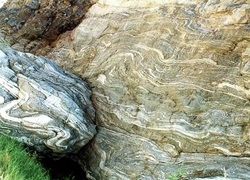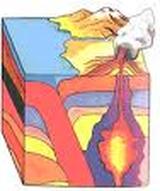Metamorphic rocks

Metamorphic rocks are formed from extreme heat or pressure. Melting does not occur. If melting does occur it is no longer a metamorphic rock but a igneous rock. There are three main features that identify metamorphic rocks, foliate, distorted structure and minerals. Foliation is the banding of minerals and are usually black and white. Distorted structure is folded layers. There are two types of key identifier minerals, garnet and mica. Garnet has a dark red color while mica is a shiny, flaky mineral. Regional Metamorphism takes place in a large geographic are. Contact Metamorphism takes place in a small geographic area. Metamorphic rock is the result of the transformation of an existing rock type, the protolith, in a process called metamorphism, which means "change in form". The protolith is subjected to heat and pressure (temperatures greater than 150 to 200 °C and pressures of 1500 bars) causing profound physical and/or chemical change. The protolith may be sedimentary rock, igneous rock or another older metamorphic rock. Metamorphic rocks make up a large part of the Earth's crust and are classified by texture and by chemical and mineral assemblage (metamorphic facies). They may be formed simply by being deep beneath the Earth's surface, subjected to high temperatures and the great pressure of the rock layers above it. They can form from tectonic processes such as continental collisions, which cause horizontal pressure, friction and distortion. They are also formed when rock is heated up by the intrusion of hot molten rock called magma from the Earth's interior. The study of metamorphic rocks (now exposed at the Earth's surface following erosion and uplift) provides us with information about the temperatures and pressures that occur at great depths within the Earth's crust.

